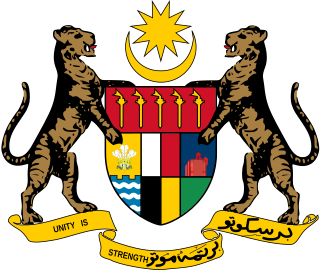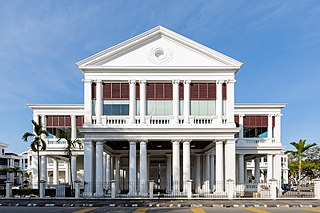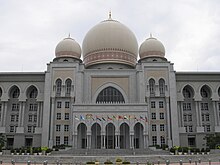
The Judicial Committee of the Privy Council (JCPC) is the highest court of appeal for the Crown Dependencies, the British Overseas Territories, some Commonwealth countries and a few institutions in the United Kingdom. Established on 14 August 1833 to hear appeals formerly heard by the King-in-Council, the Privy Council formerly acted as the court of last resort for the entire British Empire, other than for the United Kingdom itself.

The Federation of Malaya was a federation of what previously had been British Malaya, comprising eleven states that existed from 1 February 1948 until 16 September 1963. The Federation became independent on 31 August 1957, and in 1963, Malaysia was formed when Malaya united with Singapore, North Borneo, and Sarawak.
The title of Lord President of the Supreme Court was formerly the title of the head of the judiciary in Malaysia, until 1994 when the office was renamed "Chief Justice of the Federal Court".
In Malaysia, the Yang di-Pertua Negeri is a constitutional title given to the head of state in states without a ruler, namely: Penang, Malacca, Sabah and Sarawak. This is in contrast to a Ruler which is a constitutional title given to states with hereditary monarchies, namely: the Sultans of Johor, Kedah, Kelantan, Pahang, Perak, Selangor and Terengganu; the Raja of Perlis: and the Yang di-Pertuan Besar of Negeri Sembilan.

Judiciary of Malaysia is largely centralised despite Malaysia's federal constitution, heavily influenced by the English common law, as well as Islamic jurisprudence.

The legal system of Singapore is based on the English common law system. Major areas of law – particularly administrative law, contract law, equity and trust law, property law and tort law – are largely judge-made, though certain aspects have now been modified to some extent by statutes. However, other areas of law, such as criminal law, company law and family law, are almost completely statutory in nature.

Malaysian nationality law details the conditions by which a person is a national of Malaysia. The primary law governing nationality requirements is the Constitution of Malaysia, which came into force on 27 August 1957.

Malaysian legal history has been determined by events spanning a period of some six hundred years. Of these, three major periods were largely responsible for shaping the current Malaysian system. The first was the founding of the Melaka Sultanate at the beginning of the 15th century; second was the spread of Islam in the indigenous culture; and finally, and perhaps the most significant in modern Malaysia, was British colonial rule which brought with it constitutional government and the common law system.

The Supreme Court of Singapore is a set of courts in Singapore, comprising the Court of Appeal and the High Court. It hears both civil and criminal matters. The Court of Appeal hears both civil and criminal appeals from the High Court. The Court of Appeal may also decide a point of law reserved for its decision by the High Court, as well as any point of law of public interest arising in the course of an appeal from a court subordinate to the High Court, which has been reserved by the High Court for decision of the Court of Appeal.

The High Court of Singapore is the lower division of the Supreme Court of Singapore, the upper division being the Court of Appeal. The High Court consists of the chief justice and the judges of the High Court. Judicial Commissioners are often appointed to assist with the Court's caseload. There are two specialist commercial courts, the Admiralty Court and the Intellectual Property Court, and a number of judges are designated to hear arbitration-related matters. In 2015, the Singapore International Commercial Court was established as part of the Supreme Court of Singapore, and is a division of the High Court. The other divisions of the high court are the General Division, the Appellate Division, and the Family Division. The seat of the High Court is the Supreme Court Building.

The Court of Appeal of Singapore is the highest court in the judicial system of Singapore. It is the upper division of the Supreme Court of Singapore, the lower being the High Court. The Court of Appeal consists of the chief justice, who is the president of the Court, and the judges of the Court of Appeal. The chief justice may ask judges of the High Court to sit as members of the Court of Appeal to hear particular cases. The seat of the Court of Appeal is the Supreme Court Building.

In most legal jurisdictions, a supreme court, also known as a court of last resort, apex court, and highcourt of appeal, is the highest court within the hierarchy of courts. Broadly speaking, the decisions of a supreme court are binding on all other courts in a nation and are not subject to further review by any other court. Supreme courts typically function primarily as appellate courts, hearing appeals from decisions of lower trial courts, or from intermediate-level appellate courts. A Supreme Court can also, in certain circumstances, act as a court of original jurisdiction, however, this is typically limited to constitutional law.

The judicial officers of the Republic of Singapore work in the Supreme Court and the State Courts to hear and determine disputes between litigants in civil cases and, in criminal matters, to determine the liability of accused persons and their sentences if they are convicted.

The Malaysian Bar is a professional body which regulates the profession of lawyers in peninsular Malaysia. In Malaysia, there is no distinction between a barrister and a solicitor, in that, it is a fused profession. Membership into the Bar is automatic and mandatory. The bar was created under the Legal Profession Act 1976. Like other bar associations around the world, it has a wide range of functions, including, to protect the reputation of the legal profession, to uphold the cause of justice, to express its views on matters relating to legislations, and others.
The high courts in Malaysia are the third-highest courts in the hierarchy of courts, after the Federal Court and the Court of Appeal. Article 121 of the Constitution of Malaysia provides that there shall be two high courts of co-ordinate jurisdiction—the High Court in Malaya and the High Court in Sabah and Sarawak. Before 1969, the High Court in Singapore was also part of the Malaysian courts system.

The judiciary of Jamaica is based on the judiciary of the United Kingdom. The courts are organized at four levels, with additional provision for appeal to the Judicial Committee of the Privy Council in London. The Court of Appeal is the highest appellate court. The Supreme Court has unlimited jurisdiction in all cases, and sits as the Circuit Court to try criminal cases. The Parish Court in each parish hears both criminal and civil cases, excluding grave offences. The Petty Sessions are held under Justices of the Peace, with power to hear minor crimes.

The Malaysia Agreement or the Agreement relating to Malaysia between United Kingdom of Great Britain and Northern Ireland, Federation of Malaya, North Borneo, Sarawak and Singapore (MA63) was the agreement which combined North Borneo, Sarawak, and Singapore with the existing states of the Federation of Malaya, the resulting union being named Malaysia. Singapore was later expelled from Malaysia, becoming an independent state on 9 August 1965.
The Judiciary of Sri Lanka are the civil and criminal courts responsible for the administration of justice in Sri Lanka. The Constitution of Sri Lanka defines courts as independent institutions within the traditional framework of checks and balances. They apply Sri Lankan Law which is an amalgam of English common law, Roman-Dutch civil law and Customary Law; and are established under the Judicature Act No 02 of 1978 of the Parliament of Sri Lanka.

The Penang High Court, founded in 1808, is the birthplace of Malaysia's judiciary system. It is housed inside a Palladian-style building at Light Street, George Town, Penang. To this day, the High Court sits at the top of Penang's hierarchy of courts.















